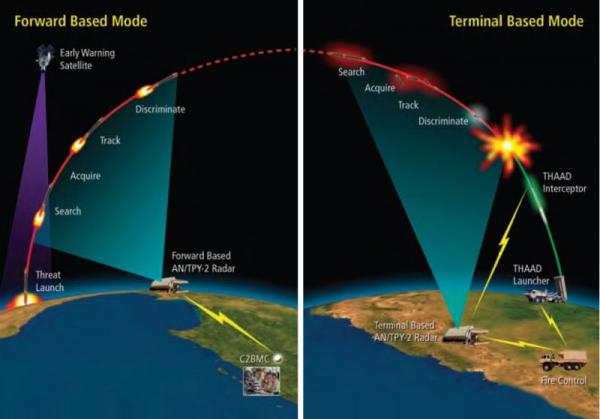Let’s face it: In the wake of DPRK’s fourth nuclear test and launching of a satellite that are condemned by the international community, it is difficult to dissuade the aggravated government of the ROK from taking further measures to beef up its military defense.

South Korea considers the deployment of the Terminal High-Altitude Area Defense (THAAD) system on Korean soil.
But deployment of the Terminal High-Altitude Area Defense (THAAD) system is not a good option.
The THAAD is a United States Army anti-ballistic missile system designed to shoot down short, medium, and intermediate ballistic missiles in their terminal phase using a hit-to-kill approach. The Korean Peninsula is only 1100km long and Seoul only 40km from the demarcation line. So most, if not all, of any missiles of the DPRK targeting the ROK can only be short-range ballistic missiles that have a maximum range of 1000km.
Threats from the North to the South in the Korean Peninsula are not primarily the short-range missiles of the DPRK, just like the THAAD is not primarily designed, if at all, for missiles flying at low altitude. The missile threats from the North to the South essentially come from KN-02, which can reach up to 120km and Hwasong-5 and Hwasong-6 with ranges of 300km and 500km respectively. If they carry conventional warheads, the threats from these short-range missiles are not greater than those Scuds fired sporadically and inaccurately by Saddam Hussein into Israel in the Gulf War. The ROK already has Pac-2 deployed against them. It has been developing its own missile-defense system. Besides, the ROK military allied with the US military won’t wait for revenge all all missiles from the North fall on the soil of the South.
Contrary to what the Ministry of Foreign Affairs of the ROK has expressed, a scenario of the North launching a nuclear attack against the South is next to impossible in the near future. The DPRK has only conducted four nuclear tests. Whether that allows it to have developed weapons-grade nuclear warheads is debated among nuclear scientists and policy makers. But making small and reliable warheads that can be fitted onto short-range missiles is difficult — second only to developing multiple nuclear warheads in terms of technological difficulties.
Should the DPRK have short-range ballistic missiles with tactical nuclear warheads one day, a successful nuclear strike from the North and even a successful interception by any missile defense systems including THAAD from the South is unthinkable. It will certainly inflict unbearable damage to both sides because of geological proximity between the North and the South. The lingering radioactive dust would make any victory on either side meaningless.
Such short-range missiles don’t appear to be a priority of the DPRK today. Its focus is on improving the capability of its nuclear bombs as demonstrated in its fourth underground nuclear test on Jan. 6, and developing an ICBM capability as demonstrated in its satellite launching on Feb. 7. The purpose of the latter is to extend the range of the missiles to reach the continental USA so as to create maximum panic on America’s part and thus increase DPRK’s bargaining chips on the table.
The real lethal weapons of the North are its 700 long–range artillery pieces-Koksan 170 MM howitzers and 240 mm multiple rocket launchers –that are capable of bombarding Seoul, a city of over 10 million people. Over a decade ago, the ambassador of the US to the ROK remarked impressively at a forum that the distance between the North and the South is only 53 seconds! That, he explained, is the time of flight of a howitzer shell landing into Seoul from the 38th parallel. Indeed it is not rare to hear from the North how its preemptive strike could turn Seoul into “a sea of fire”. Admittedly, no defense systems including the THAAD would be able to shield off a shower of artillery shells in such a doomsday scenario.
Citing the need to defend against DPRK’s missiles with the THAAD is either out of a paranoia that has hijacked the South Koreans or a deliberate play of security populism to pacify people or more likely, a bit of both. But it comes at financial and political costs, too.
Financially one battery of THAAD defense system consists launcher, interceptors, a fire control and communications unit, and an AN/TPY-2 radar costs no less than $1 billion. This is more than the cost of $866,5 million paid in 2014 by the South Korean government for 28,500 US troops stationed in Korea. South Korean defense officials said at least two THAAD batteries are needed to thwart missile attacks from the North, but who is going to pay – Washington or Seoul? Why the US if South Korea is free rider? And why South Korea if it is, as claimed, meant more for protection of American troops? This has been a hot-button issue in recent years.
Politically, such an installation will surely be taken by the DPRK as provocation and accelerate the vicious cycle of action vs. reaction. Last but not least, it has already invited strong protests from the Chinese government, which believes THAAD, if deployed, will be integrated into American missile defense network in East Asia and affects its security interests. Russia, too, believes it destabilizes strategic equilibrium in the region.
The deployment of THAAD on Korean soil can only be a bad example of how anger and angst can overpower and replace rational response. It is like seeking a hare in a hen’s nest.


